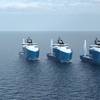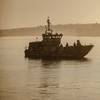With more than 300 lean-burn, spark-ignited gas engines supplied for stationary power applications over the past 15 years, Rolls-Royce is making a determined bid to break into the marine propulsion market with its newly-bolstered series of Norwegian-developed, gas-fueled Bergen engines. The preparation of the K-G4 type for shipboard use, plus the unveiling of the altogether more potent B35:40V-G design, have been driven by mounting environmental legislation and by national commitments to air pollution reduction attendant to the Kyoto Protocol.
While cognizant of the longer-term, international market scope, the business rationale in developing a marine offering of environmentally-friendly reciprocating prime movers, conceived for 100-percent operation on gas, has an immediate national relevance, given the opportunities presented by Norway's investment in its LNG fuel supply infrastructure. A government-inspired project for five gas-fuelled, double-ended road ferries to serve two of the country's longer fjord crossings is expected to provide an important platform for the technology, and the gradual extension of LNG bunkering points along the sea rim, coupled with a circumspect national energy policy, is expected to stimulate the uptake of gas-fuelled power and propulsion plant in coastal and offshore vessels. A small Norwegian LNG tanker and a modern fjord ferry currently use LNG as fuel in their high-speed engine plant, while two sophisticated offshore support vessels working Norwegian fields are distinguished by dual-fuel, medium-speed prime movers. The planned adoption of dual-fuel plant in French LNG carrier newbuilds has provided a fillip to the advocates of that technology. However, Rolls-Royce contends that its medium-speed, purely gas-ingesting machinery provides a simple, highly effective solution to low-emission powering needs, lending itself both to direct mechanical coupling to propellers and thrusters, and to shipboard electricity production. Moreover, test results have demonstrated that there are no operational limitations on sustained low load or transient operations.
Among the claimed advantages of employing lean-burn, gas-fuelled, Otto cycle engine technology are the low level of Nox (oxides of nitrogen) emission and the negligible release of Sox (oxides of sulfur) and particulates. LNG as a fuel has the attraction that its carbon content is lower than other hydrocarbon fuels such as diesel oil. If it is efficiently burned, the CO2 (carbon dioxide) emissions from the engine are correspondingly low, a very positive factor for countries that have signed up to the Kyoto Agreement, and salient also to anticipated future international edicts governing CO2 from ships' machinery. An added economic benefit is that lube oil consumption is low, and oil change intervals are long.
The main frame and much of the running gear of the K-gas engine is derived from the successful Bergen K-series diesel engines used in hundreds of vessels. A power output of 220-kW per cylinder is available, with running speeds between 600- and 1,000-rpm. The K-G4 has been released in configurations of 6, 8 and 9 in-line cylinders, and in 12-, 16- and 18-cylinder vee-form, covering unit powers to approximately 4,000-kW. If required at some later stage, K-gas engines can be converted for operation on marine diesel oil, and the company has also declared its readiness to convert K diesel engines to burn gas. A much larger, lean-burn, spark-ignition engine, founded on the B32:40 diesel engine hardware and K-gas engine technology, has been launched for unit power needs up to 8,800-kW. Offering 440-kW per cylinder, in vee-type models of 12, 16 and 20 cylinders, the B35:40V-G design is said to have a thermal efficiency of 47-percent. Although the B-gas engine has been primarily conceived for the expanding market for reciprocating engines for stationary, industrial uses, the 350 mm-bore design offers scope as a marine power unit. In its 20-cylinder layout, the new Norwegian-built offering is claimed to be the world's most powerful spark-ignited, reciprocating gas engine.
Featured videos

Inmarsat Enhances Service to Drive Digitalization

Inside the Electrified Truckable Tug

Tracking Foreign Vessels Working in the U.S. Jones Act Market
Subscribe for
Maritime Reporter E-News
Maritime Reporter E-News is the maritime industry's largest circulation and most authoritative ENews Service, delivered to your Email five times per week









